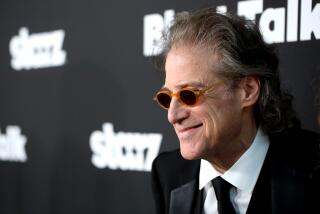Jerry Lewis ousted as MDA telethon host
For the first time in 45 years, Jerry Lewis will not be pleading for donations in front of a camera Labor Day weekend after he was abruptly dismissed as the host of the Muscular Dystrophy Assn.’s telethon, an event that drew attention to the childhood disease and in its heyday was an annual television highlight.
The group said the 85-year-old legendary comedian would not appear on this year’s telethon, and would no longer serve as its national chairman, a position he held for nearly 60 years. The telethons have raised nearly $2.5 billion, the MDA said.
The announcement and the mysterious circumstances surrounding Lewis’ departure provoked an outcry from comedians and other performers, who still widely revere him for his groundbreaking routines and public service.
PHOTOS: Jerry Lewis and the MDA telethon
“As a fellow comedian, it’s really crappy the way they treated him,” Paul Rodriguez said. “The man is an institution. They should have found a better way to let him go.”
The MDA said it did not expect to name a new host this year and that the Sept. 4 event would be shepherded by entertainment personalities Nigel Lythgoe, Jann Carl, Alison Sweeney and Nancy O’Dell.
“Jerry Lewis is a world-class humanitarian and we’re forever grateful to him for his more than half century of generous service to MDA,” said MDA Chairman of the Board R. Rodney Howell.
The decision represented an about-face from the MDA’s announcement in May that Lewis would host the telethon for a final time this year, and would appear in the closing moments of future telethons to sing his trademark number, “You’ll Never Walk Alone.”
The marathon telecast was once a must-stop venue for comedians and entertainers. During the height of its popularity, the telethon featured performances from show business luminaries, including Sammy Davis Jr., Liberace, the Supremes, Johnny Cash and Frank Sinatra.
In recent decades, the event’s appeal faded with younger viewers who found the format somewhat dated. Indeed, the telethon model itself as a fundraising vehicle lost much of its force, particularly with the rise of the Internet, which emerged as a more potent generator of donations.
Even before ousting Lewis, the MDA was poised to scale back the telethon from more than 20 hours to as few as six, primarily because stations were threatening to drop all or part of the telecast.
The telethon’s earning power had declined in recent years. According to public tax filings, the telethon brought in $56.4 million in gross receipts in 2005.
But in 2009, the latest year for which records are available, the tally dropped to $45.6 million.
A spokeswoman for Lewis said the star had no comment on his exit from the telethon. But others rallied to Lewis’ defense.
Jamie Masada, the longtime owner of the Laugh Factory in Los Angeles, said he’s received a dozen messages from comedians, including Dane Cook and Dave Chappelle, expressing anger over the way Lewis had been let go.
“He’s the face of the telethon,” Masada said. “Without him, there’s no show.”
Lewis said Saturday at the Television Critics Assn. press tour in Beverly Hills that he saw himself continuing, in part because his role as host went beyond a show business opportunity.
When a questioner asked what he would have to do to be satisfied with his life, he replied: “Get the cure for muscular dystrophy, then I’m fine.”
The disease is a group of more than 40 disorders that affect more than 1 million Americans. The maladies, sometimes referred to as neuromuscular disorders, weaken the muscles and eventually result in profound disability. The most common form of the disease is Duchenne muscular dystrophy, which affects about 1 in 3,500 males worldwide.
But despite the money Lewis raised to fight these disorders, the telethon may represent an old-fashioned image of the state of research and progress on the disease, some experts said. Scientific advances in understanding the illness have accelerated in recent years with a number of new treatments in the pipeline.
The notion of sick children, experts said, contradicted the current reality in which patients lead full lives into their 30s and even beyond. “When the disease wasn’t treatable, it was sadness and poster children,” said M. Carrie Miceli, co-director of the Center for Duchenne Muscular Dystrophy at UCLA. “The new image is not as pitiful as much as empowering.”
Although Jerry Lewis and the national telethon may be the only awareness many Americans have of muscular dystrophy, that is changing, several experts said. A group called Cure Duchenne launched a highly visible awareness campaign this year, with sponsorship from Cadillac, that included an appearance by NFL linebacker Clay Matthews and singer Justin Bieber.
Still, MDA’s announcement marked the end of an era for one of the world’s most beloved living performers. Lewis began a small-scale telethon in 1954, not long after which he also became MDA’s national chairman. He expanded it into its current format as a marathon special in 1966, first in New York and then in Las Vegas. Over the last 45 years, he had turned a generic fundraising event into a fixture of the entertainment calendar. Lewis’ efforts with the organization also helped earn him the Oscars’ Jean Hersholt Humanitarian Award.
On the telecast, Lewis could provide a dose of spontaneity — and sometimes gaffes — to what would otherwise be a stuffy setup. Lewis presided over a telethon that could stretch more than 21 hours and mixed heartfelt appeals featuring sick children with classic comedy, musical entertainment and special guests.
Perhaps its most famous moment came in 1976, when Sinatra helped arrange a reunion between Lewis and longtime partner Dean Martin, with whom he had fallen out. Ten years later, Lewis and Sammy Davis Jr. made headlines when they performed a memorable split-screen Amos ‘N Andy routine on the telecast.
But Lewis’ involvement hasn’t been without controversy. In 2007, Lewis nearly let slip a homophobic epithet. Lewis also raised the ire of women’s groups over the years with several disparaging comments; in 1986 he mockingly noted a female reviewer’s menstrual cycle, prompting some groups to call for him to leave the telethon.
Not all comedians were surprised that Lewis wouldn’t be continuing with MDA.
“It’s probably time for him to retire,” Tom Arnold said. “But he should get to say goodbye.
“If they’d promoted this as Jerry Lewis’ final telethon they could’ve gotten guys like George Clooney, which would’ve opened the door to God knows who. It would’ve been a big deal, and showbiz loves big deals.”
PHOTOS: Jerry Lewis and the MDA telethon
Times staff writers Shari Roan and Harriet Ryan contributed to this report.
More to Read
The biggest entertainment stories
Get our big stories about Hollywood, film, television, music, arts, culture and more right in your inbox as soon as they publish.
You may occasionally receive promotional content from the Los Angeles Times.








